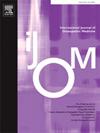整骨疗法对两次心脏手术患者的影响-一例报告
IF 1.5
4区 医学
Q2 MEDICINE, GENERAL & INTERNAL
引用次数: 0
摘要
手术疤痕通常会导致疼痛并影响功能。整骨疗法可能是一种有价值的护理选择,特别是对于那些在合理的恢复期后尚未完全恢复健康的患者,但其作用机制尚不清楚。目的:本研究旨在描述在新兴模型的指导下,骨科干预如何支持改善与胸外科手术后果相关的患者状况。病例描述:一名56岁女性,因心内膜炎(15岁和55岁)接受了两次胸廓心脏手术,自上次手术以来,出现了严重的功能限制(呼吸幅度减小、胸骨区域剧烈疼痛、仰卧和俯卧困难、行走时缺乏耐力、睡眠质量差、日常活动受限),并出现了可能与这些症状相关的姿势障碍。有感觉减退和敏感迹象提示疼痛灾难。初步评估后,患者接受了4次1小时的整骨疗法。医学结果研究简表60 (MOS SF-36)的9项指标中有4项得到改善:一般健康状况、疼痛程度、一般健康指标和身体功能的估计。疼痛从7减少到3/10,步行距离增加到1.6公里以上。尽管术后骨科干预通常涉及疤痕组织工作以恢复局部组织活动或主要是肌肉骨骼活动,但在本病例中,干预是由多种模型指导的,包括内感受、生物心理社会框架和以患者为中心的方法,以配合患者的病情和恢复潜力。本文章由计算机程序翻译,如有差异,请以英文原文为准。
Effects of osteopathic treatments in a patient who underwent two cardiac surgeries - A case report
Introduction
Surgical scars often lead to pain and can impact function. The osteopathic approach could be a valuable care option, especially for patients who have not fully recovered their health after a reasonable recovery period, but the mechanisms of action remain unknown.
Objective
This study aims to describe how osteopathic interventions, guided by emerging models, can support the improvement of a patient's condition related to the consequences of thoracic surgeries.
Case description
A 56-year-old woman who underwent two thoracic cardiac surgeries (at 15 and 55 years old) post-endocarditis suffered, since the last surgery, from severe functional limitations (reduced respiratory amplitude, severe pain in the sternal region, difficulty lying on her back and stomach, lack of endurance when walking, poor sleep quality, limitations in daily activities) and presented with postural disturbances potentially related to these symptoms. There were hypoesthesias and sensitivity signs suggestive of pain catastrophizing.
Outcomes
Following initial evaluation, the patient received 4 one-hour osteopathic treatments. Four out of nine indicators of the Medical Outcome Study Short Form-60 (MOS SF-36) have improved: estimation of general health status, level of pain, general health indicator, and physical functioning. Pain decreased from 7 to 3/10 and walking distance increased to over 1.6 km.
Conclusion
Although post-surgical osteopathic interventions often involve scar tissue work to recover local tissue mobility or primarily musculoskeletal maneuvers, in this case, the interventions were guided by multiple models—including interoception, the biopsychosocial framework, and a patient-centered approach—to align with the patient's condition and recovery potential.
求助全文
通过发布文献求助,成功后即可免费获取论文全文。
去求助
来源期刊
CiteScore
2.20
自引率
36.80%
发文量
42
审稿时长
3 months
期刊介绍:
The International Journal of Osteopathic Medicine is a peer-reviewed journal that provides for the publication of high quality research articles and review papers that are as broad as the many disciplines that influence and underpin the principles and practice of osteopathic medicine. Particular emphasis is given to basic science research, clinical epidemiology and health social science in relation to osteopathy and neuromusculoskeletal medicine.
The Editorial Board encourages submission of articles based on both quantitative and qualitative research designs. The Editorial Board also aims to provide a forum for discourse and debate on any aspect of osteopathy and neuromusculoskeletal medicine with the aim of critically evaluating existing practices in regard to the diagnosis, treatment and management of patients with neuromusculoskeletal disorders and somatic dysfunction. All manuscripts submitted to the IJOM are subject to a blinded review process. The categories currently available for publication include reports of original research, review papers, commentaries and articles related to clinical practice, including case reports. Further details can be found in the IJOM Instructions for Authors. Manuscripts are accepted for publication with the understanding that no substantial part has been, or will be published elsewhere.

 求助内容:
求助内容: 应助结果提醒方式:
应助结果提醒方式:


